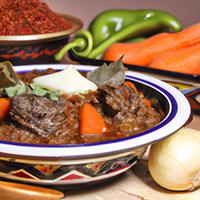
1 serving (300 grams) contains 450 calories, 10.0 grams of protein, 15.0 grams of fat, and 60.0 grams of carbohydrates.

Log this food in SnapCalorie

Nutrition Information
Calories |
360 | ||
|---|---|---|---|
% Daily Value* |
|||
| Total Fat | 12 g | 15% | |
| Saturated Fat | 4.0 g | 20% | |
| Polyunsaturated Fat | 0 g | ||
| Cholesterol | 16.0 mg | 5% | |
| Sodium | 480 mg | 20% | |
| Total Carbohydrates | 48 g | 17% | |
| Dietary Fiber | 2.4 g | 8% | |
| Sugars | 1.6 g | ||
| protein | 8.0 g | 16% | |
| Vitamin D | 0 mcg | 0% | |
| Calcium | 32.0 mg | 2% | |
| Iron | 1.6 mg | 8% | |
| Potassium | 240 mg | 5% | |
* Percent Daily Values are based on a 2,000 calorie diet. Your daily values may be higher or lower depending on your calorie needs.
Food Attributes
Source of Calories
About Tahdig with khoresht
Tahdig with Khoresht is a staple dish in Persian cuisine, celebrated for its unique textures and rich flavors. Tahdig refers to the crispy, golden rice layer at the bottom of the pot, often enhanced with saffron or yogurt for added aroma and crunch. Khoresht is a slow-simmered stew, typically made with vegetables, herbs, legumes, and meat, like lamb or chicken, providing protein and essential vitamins. Common khoresht variations include Ghormeh Sabzi, a herb stew with kidney beans, or Fesenjan, made with pomegranate and walnuts. Tahdig offers energy through carbohydrates, while the stew delivers nutrient-rich ingredients like fiber and antioxidants. That said, Tahdig’s crispiness is achieved with oil or butter, which can be high in fats, and salt content should be monitored in certain recipes. When balanced with fresh herbs and lean protein, Tahdig with Khoresht is a wholesome celebration of Persian culinary tradition.



